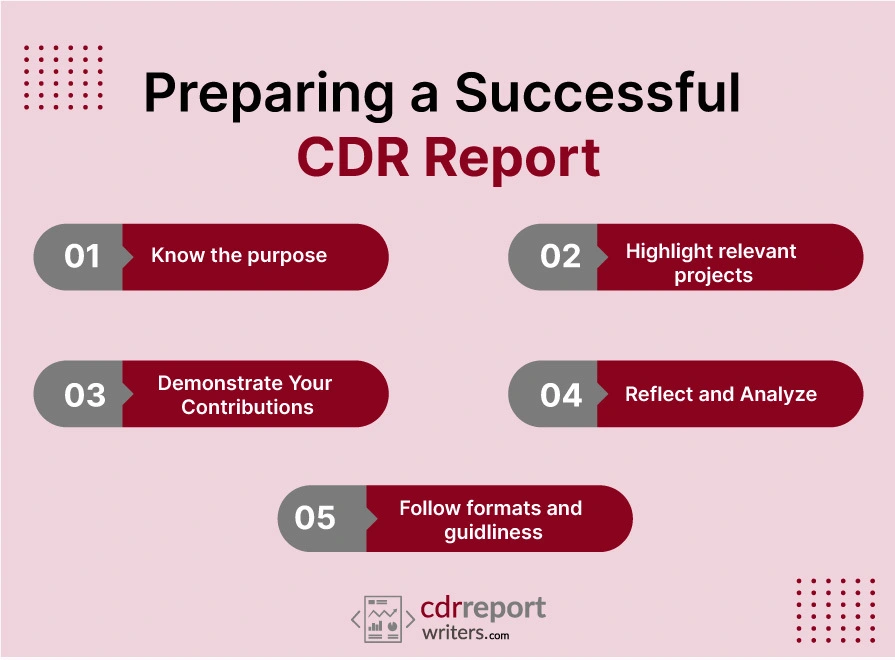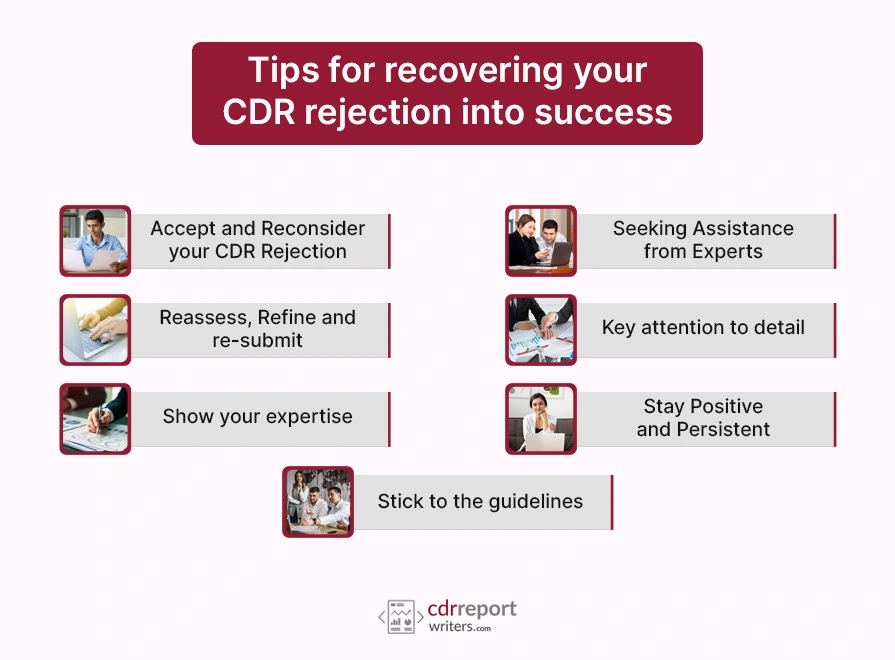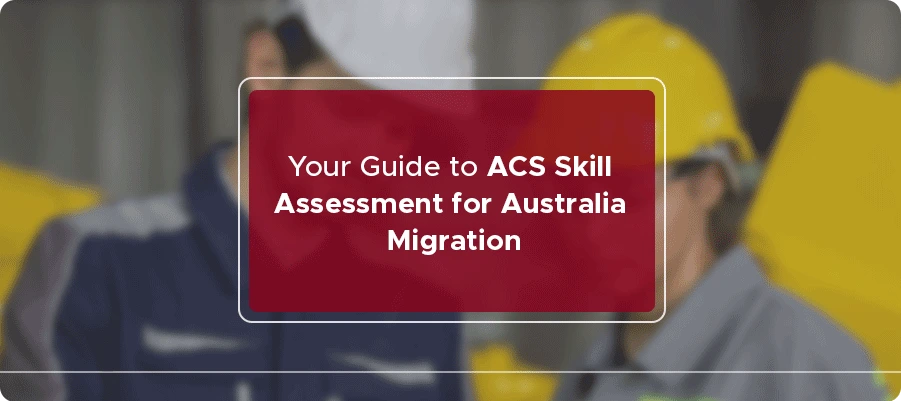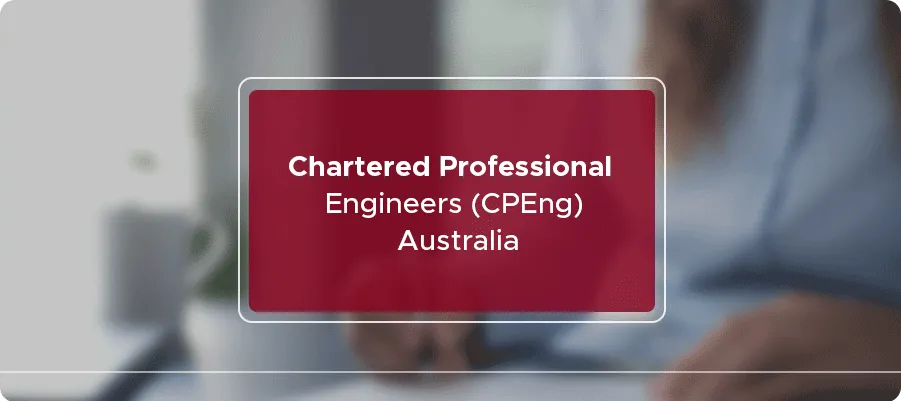
Successfully Recovering from a CDR Rejection: Full Guide 2024
Facing a CDR rejection can feel really tough, especially after putting in so much time and effort. But it’s important to remember that setbacks can lead to great comebacks.
A CDR rejection doesn’t mean your dreams are over. Instead, it’s a chance to look back, improve, and come back even stronger. This guide will help you turn your CDR rejection into a stepping stone for success.
The Competency Demonstration Report (CDR) is very important in the skill assessment process. It shows an engineer’s skills, knowledge, and experiences. Engineers Australia uses it to decide if someone is fit for a job in the Australian engineering field.
Making this report carefully is crucial because its acceptance or rejection can greatly affect your career chances in Australia.
🔑 Key Highlight
- CDR is very important for Engineers Australia and helps decide if someone is eligible for engineering jobs in Australia.
- Getting a CDR rejected can be hard, but it gives you a chance to improve and learn.
- There are several reasons why a CDR might be rejected, such as not providing enough evidence, copying others’ work, having poorly written content, using the wrong format, or giving incorrect information.
- If your CDR is rejected, it’s important to accept it, get help, make improvements, pay attention to details, and clearly show your engineering skills and experiences.
What is a Competency Demonstration Report (CDR)?
A Competency Demonstration Report (CDR) is a detailed document that engineers need to create if they want to move to Australia for work. Engineers Australia, the organization in charge of assessing engineers’ skills, uses this report to check if the engineer’s education and work experience meet their standards. This report is very important because it helps Engineers Australia decide if the engineer is qualified to work in Australia.
Why is CDR Important?
Some of the importance of CDR for Engineers are :
- Validation of Skills and Competencies: The CDR shows how good you are at engineering, what you know, and the experience you have. It proves you have the skills needed to work as an engineer in Australia, following their rules.
- Migration Purpose: In Australia, if engineers want to move there for work, they need to submit something called a CDR. That stands for Competency Demonstration Report. Engineers Australia looks at this report to decide if the engineer’s qualifications and experience match what’s needed in Australia. If they do, it helps the engineers get visas to work there.
- Professional Recognition: Having your Competency Demonstration Report (CDR) accepted by Engineers Australia can help you move to Australia and get recognized as a skilled engineer. It proves your abilities and can lead to more job opportunities in Australia.
Understanding the common reasons for CDR Rejection
There are several reasons why Engineers Australia might reject a Competency Demonstration Report (CDR). Knowing these common mistakes is important to improve your application and avoid rejection.
Often, these mistakes happen because of not enough detail, a poor understanding of competency elements, and inconsistencies in showing engineering skills and career growth.
This section will look at these common errors, offering advice on what Engineers Australia expects and how to clearly show your abilities and experiences in your CDR Report Sample.
- Insufficient Competency: Engineers Australia might refuse to accept Competency Demonstration Reports if they don’t show enough evidence of the applicant’s engineering skills. It’s crucial to describe the tasks done and how engineering abilities were used.
- Plagiarism: Engineers Australia really doesn’t allow copying in your report. If you copy stuff or don’t make it your own, they might not accept it. So, when you’re writing your report, make sure it’s all your own words and ideas. That way, you won’t get in trouble!
- Badly Career episodes writing: Make sure your report is neat, detailed, and easy to follow. You want to clearly explain how you contributed to engineering projects. Reports that are messy or hard to understand might not be accepted.
- Lack of Proper format: It’s super important to stick to the format provided by Engineers Australia. If you don’t, your work might get rejected. Make sure your document follows all the rules and guidelines they give you.
- Inaccurate Information: To gain trust and approval, ensure your report contains accurate and relevant information that can be verified. Inaccuracies and irrelevant details can lead to rejection.
- MSA Booklet Guidelines: To avoid your career episodes getting rejected, follow the MSA booklet rules closely. Always use “I” even for team projects, focusing only on your role. Keep it clear and stick to the guidelines.
- Word Count Specifications: Your CDR report should be 6000-6800 words, covering your CV, CPD section, three career stories, and a summary statement. Each career story should range from 1000 to 2500 words, with about 1500 words for CPD and the Summary Statement. Missing these limits for career stories may lead to rejection, a common cause for CDR rejection.
It’s super important to follow Engineers Australia’s rules when you’re putting together your Competency Demonstration Report (CDR). These guidelines help you show off your skills and experiences in a clear and simple way. Knowing these guidelines well is key to making sure your report meets all the criteria. So, be sure to study them carefully before you start working on your CDR!
Recovering your CDR Rejection and turning it into success
You can turn a rejected CDR into a success by showcasing your skills better. Even if your CDR was rejected before, you can still improve your chances of getting a job by highlighting what you’re good at.
According to a survey, international graduates who find full-time jobs often feel more ready for work than local graduates. This is true for different levels of study.
For example, 91.9% of postgraduate research graduates felt well-prepared. Undergraduates were next at 80.3%, and postgraduate coursework graduates were at 78.2%. This shows that having the right skills makes it easier to find a job.
Tips for recovering your CDR rejection into success:
- Accept and Reconsider your CDR Rejection: So, it seems your CDR got rejected. Take a moment to think about why that might have happened. What can you do to make it better next time?
- Seeking Assistance from Experts: You might want to ask experts who know about CDR writing or engineering to help you. They can give you good advice on how to make your report better.
- Reassess, Refine and re-submit: Once you know what needs fixing, make the changes to your CDR. Make sure to fix the things the rejection letter talked about before you send it again.
- Key attention to detail: Make sure you follow the rules given by Engineers Australia carefully. Check everything in your report, from how it’s laid out to how many words you’ve written, to make sure it’s all okay.
- Show your expertise: I’m really good at engineering, and I’ve done some impressive things that show why I’m perfect for this job. I’ve got the skills and experience to excel in this role. Let me tell you more about why I’m the best choice.
- Stay Positive and Persistent: Even if you get turned down, don’t let it bring you down. Rejection doesn’t mean you won’t reach your goals. Just keep going, stay positive, and keep working hard. Success is still within your reach.
- Stick to the guidliness: Make sure your updated CDR follows all the rules given by the people checking it. Pay attention to how it looks, how many words you use, and other stuff they’ve asked for, so they don’t say no because of technical reasons.

Preparing a Successful CDR Report
- Understand the Purpose: Before starting, it’s important to know that a CDR Report is like a showcase of your engineering skills. It’s about showing how well you can use your engineering knowledge to solve real-world problems. Engineers Australia looks for certain skills in these reports.
- Showcasing Key Skills: Engineers Australia wants to see if you have skills like problem-solving, technical know-how, and innovation. They want to know if you can apply your engineering knowledge effectively.
- Highlight relevant projects: You should choose projects that best show off your engineering skills. Each project should highlight how you solve problems, use technical knowledge, and come up with new ideas to overcome challenges.
- Demonstrate Your Contributions: Make sure to explain what you did in each project. Talk about how you contributed to the team and how your work helped the project succeed. Use “I” to show that you were actively involved.
- Reflect and Analyze: It’s not just about describing what you did. You should also think about what you learned from each experience. This shows that you’re always trying to improve and learn new things.
- Following the Rules: It’s important to follow the rules when writing your CDR Report. This means organizing it correctly, sticking to word limits, and using the right fonts and spacing. A well-organized report shows that you’re professional and careful.
How can professionals help in CDR Report Writing ?
- Recognizing the Need for Professional Assistance: If you don’t know much about CDR Reports, find it hard to talk about your work experience, or aren’t good at English, it’s smart to get help from pros.
- Technical Writing Proficiency: Professionals who help with CDR Reports are good at writing in a clear and convincing way.
- Addressing Previous Rejections: If Engineers Australia said no before, pros can help fix what went wrong and make it better.
- Ensuring Compliance and Standards: Pros know all the latest rules from Engineers Australia, so they make sure your CDR follows them and is really good.
- Managing Time Constraints: Professionals can help you finish your CDR on time, so you don’t have to worry about deadlines.
- Enhancing Report Quality with Professional Help: With professional help, your CDR will be better, which means you have a better chance of getting approved by Engineers Australia.
Benefits of having professional guidance for CDR Report Writing
- Expertise: When you hire professional writers to help with your CDR, you benefit from their years of experience. They know exactly what Engineers Australia wants, which is super important for getting your report approved.|
- Familiarity with Guidelines: These professionals are expert in guidance in what Engineers Australia expects, so they’ll make sure your report follows all the rules.
- Time and Stress Reduction: Engaging with experts saves considerable time and reduces the stress associated with the CDR preparation process.
- Streamlined Focus: Professionals know how to make your report stand out. They focus on the most important stuff and make sure it’s all up-to-date and done right.
- Tailored Approach: They’ll make sure your strengths and experiences shine in your report. It’s all about making you look good!
- Error Prevention: These writers are eagle-eyed when it comes to finding mistakes. They’ll catch anything that could get your report rejected.
- Language Enhancement: If English isn’t your first language, pros can help make sure your CDR sounds clear, professional, and technical. That way, it’s easier to understand and has a bigger impact.
Tips for Future CDR Success
Stay Updated: Regularly check for updates to Engineers Australia’s guidelines to make sure your CDR follows the latest standards.
Continuous Improvement: Learn from the feedback you receive and keep working on improving your skills and experiences.
Network with Peers: Connect with other engineers who have successfully completed their CDR. They can offer valuable insights and tips.
Why should you choose us to prevent your CDR Report from being rejected by Engineers Australia?
We’re experts at avoiding common mistakes that lead to rejection. Our services include top-notch CDR writing, reviewing, samples, and tutoring.
Our extensive experience ensures your CDR is plagiarism-free and approved by Engineers Australia. It’s a smart move to hire us for your CDR Report.
- Deep Understanding of EA Requirements: We have a comprehensive understanding of Engineers Australia (EA) requirements, ensuring your CDR report adheres to their standards and guidelines.
- Experienced Team of Professionals: With a team of 1000+ professional experts, we have the manpower and expertise to handle any engineering faculty efficiently, covering all branches of engineering.
- Domain-Specific Writers: Our team includes domain-specific writers who are well-versed in various engineering disciplines, ensuring that your CDR is written with precision and accuracy in your field of expertise.
- Customized Services: We provide tailored CDR tutoring and reviewing services, catering to the specific needs of individuals who require assistance in writing their CDR reports.
- Quality Assurance: Our rigorous review process ensures that each CDR report undergoes thorough scrutiny to eliminate errors and inconsistencies, reducing the risk of rejection.
- Timely Delivery: We prioritize timely delivery, ensuring that your CDR report is completed within the specified timeframe, allowing you to meet EA submission deadlines without any delays.
- Proven Track Record: With a history of successful CDR submissions, we have a proven track record of helping individuals secure approval from Engineers Australia, minimizing the likelihood of rejection.
- Continuous Support: We offer ongoing support and guidance throughout the CDR writing process, addressing any concerns or queries you may have to ensure a smooth and stress-free experience.
Get a Free Consultation from Our Professionals for CDR Rejection Assistance✨🚀
Conclusion
Facing a CDR rejection can be tough, but it’s also a chance to improve. Take this time to look at your skills and make sure your next submission shows your abilities clearly to Engineers Australia.
This can help you better understand your own engineering journey. Learn from the rejection, use smart strategies, and get professional help if needed. This will make your CDR stronger and improve your chances of success.
Many engineers have been through this and succeeded. Let their stories inspire you to work hard on your CDR. With determination and effort, you can turn this setback into an opportunity for a successful engineering career in Australia. Keep trying, and your hard work will pay off.
FAQs
What is a Competency Demonstration Report (CDR)?
This question provides a fundamental understanding of what a CDR is, which is essential for individuals unfamiliar with the term.
Why is a CDR important for engineers?
Understanding the importance of a CDR is crucial for engineers considering migration to Australia, as it emphasizes the significance of the document in validating their skills and facilitating their professional endeavors.
How can I recover from a CDR rejection?
This FAQ offers actionable steps for individuals facing CDR rejection, providing guidance on how to approach the situation positively and improve their chances of success in subsequent submissions.
How can I prevent my CDR report from being rejected?
Preventing CDR rejection is a key concern for applicants, and this question addresses proactive measures they can take to ensure their submissions meet the necessary standards and guidelines.
Is it possible to turn a CDR rejection into success?
This question offers hope and encouragement to individuals who have faced rejection, emphasizing the possibility of overcoming setbacks and achieving success with perseverance and determination.






